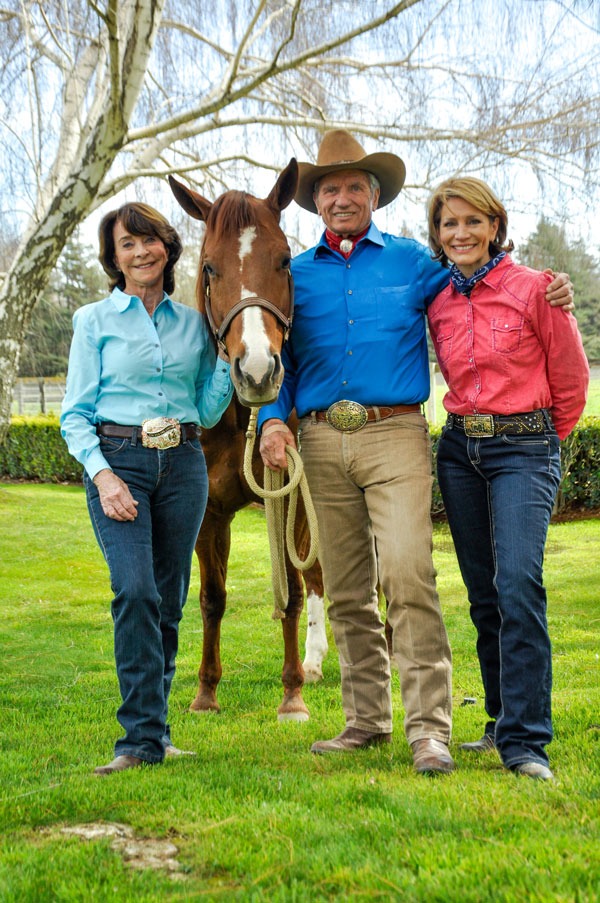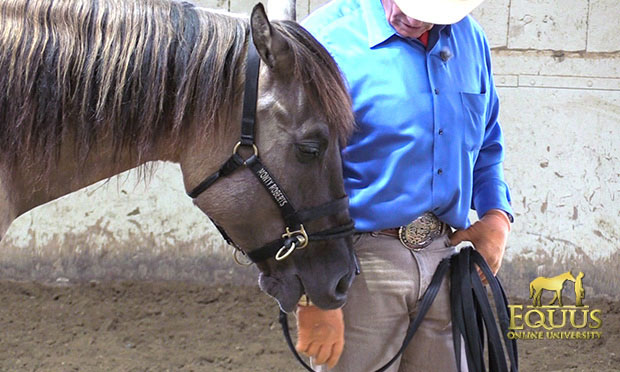How to Stop a Horse Biting – in 5 Seconds
One of the most frequently asked questions at Monty Roberts demonstrations around the world is “How do I stop my horse biting me?” I’m pleased I can tell you a biting horse is one of the easiest remedial issues to fix, and can be done in 5 seconds (by any horse owner).
But, in order to remedy the problem, you first need to understand what caused the behavior.
Why Do Horses Bite?
Horses are naturally flight animals and always aware of their surroundings, even if they are comfortable around you and their home in the stable or backyard. It’s in their nature to keep one eye out on their surroundings while they keep the other eye on you, even if its just to watch for any food you might present to them. Their field of vision is wider than ours.
Baby horses, just like baby people, explore their world with their mouth. Biting is a part of that testing out their environment. Some babies even like the reaction they get when they bite, like it’s a game. It can be playful and harmless when they are small, but mother horse knows to put a stop to excessive rough play while a foal is learning its boundaries.
We, as handlers of young horses, eventually need to set boundaries around ours bodies too, to keep things calm and safe. Young horses may be small by comparison with a fully grown adult horse, but they are still much quicker and bigger than people by the time they are weaned from their mothers and begin to interact with us. If you set the boundaries early, they might never take advantage of those differences.

Hand Feeding a Horse is the #1 Cause of Biting
When I was eight years old, we lost a mare and I was offered the baby to care for as an orphan. There was no surrogate mother to be found, which would have been ideal.
Orphans are never easy to raise because its unnatural for a horse to grow up being bottle fed and handled by humans, without being taught their own herd rituals or being disciplined by their mother.
Doing our best, we acquired a lactating goat and my Dad (Monty Roberts) built a stand for the goat to climb up onto in order to nurse the little filly. I called her Nila’s Doll as a tribute to her mom and to the filly’s cute looks, a bright chestnut with a star on her forehead.
The next year was an effort to help Nila grow up with ground manners and boundaries. Her needs grew from one goat to two.

Me, Debbie Roberts Loucks (right) with my parents Pat and Monty Roberts
She never became a biter because I cared too much for her happiness. A spoiled horse is rarely a happy horse. I wanted to give her the best chance for a good life, after a rough start.
I was taught that one of the most common mistakes people make is feeding a horse from the hand. To the owner who feels like it shows love, it may seem like an opportunity to build a bond and make the horse eager to see the owner coming. But, given their size, horses coming to view you as a source of food is never a good idea.
Rather, if you’d like to give your horse (appropriate) treats like carrots or apples – toss them in a bucket instead of delivering them with your hand.
Food is Not a Natural Reward
You may think of your horse as a companion like a dog or cat, but the horse is a prey animal, and food is not naturally ‘earned’ in the same way as the animal that is taught to stalk its food. As Monty Roberts says:
“No blade of grass ever ran from a horse”.
By training the horse that food is a reward, or even an entitlement, offered from the human body, demanding food is their next step. You have created a horse that will bite your pockets, hands and other parts of your body searching for food.

Other times a horse may bite because of a tightly fitting girth or uncomfortable saddle, a display of frustration or aggression, or as an attempt at mutual grooming.
Once you have a biter, whether you acquired the horse with the habit or you created one, how do stop the horse from continuing this dangerous behavior?
How to Stop a Horse Biting
Getting in a fight with a 1000-pound animal is not the answer. And hitting your horse is never ok, nor will it solve the problem. They will just get faster and better at biting and holding on.
Here is an effective and simple solution my Dad taught me – using the art of distractibility.
You know how it’s funny to distract people with the “look over there!” while you grab some of their French fries? Or how you can distract kids who are having a melt-down with an attention getting, “let’s go to the park!” Distractibility works for horses too.
The Monty Roberts Remedy for a Biting Horse
When the horse reaches to bite you, look straight ahead and tap him lightly on the shin of his leg with your foot. Do NOT create pain, just surprise. You want him to associate his effort to bite with a distracting tap on his shin. No fights.
Horses are associative thinkers. And, associating the thought of biting with another part of his body, namely his front leg, is a form of behavior habituation or modification. The trick is to be quick so he will associate the tap with the effort to bite.
Sometimes I will deliver a quick rub on the coronet band with my boot. Either works, especially if it seems unrelated to your actions. I just look ahead and act as if nothing happened.
It only takes about six or eight times and you will see the horse begin to bite, hesitate and look down at his leg. Its pretty cute, actually, to watch their brains work.
Video Tutorial: How to Stop Nipping and Biting
If you’d like to see these steps in action, take a look at the Monty Roberts Online University video: How to Stop Nipping and Biting. You can use the promocode DAYPASS for free access.
Also see the Ask Monty: Is it ok to hit the horse who bites you Q&A for more on why it’s never ok to strike the biting horse.
Best wishes,
Debbie Roberts-Loucks


